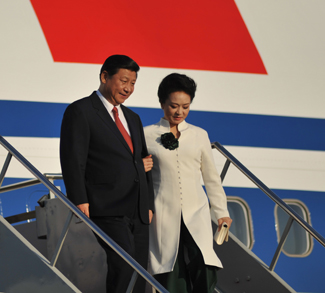Compared to China, the United States comes in behind in terms of its industrial basis, annual manufacturing output, and industrial export. It boasts a superior labor productivity in the manufacturing sector, but this still does not come close to offsetting the 10x larger labor force output of China in these sectors. China also maintains control or at the very least significant influence over more industrial supply chains than all the Western countries combined.
This is why the United States needs allies to maintain its economic and geopolitical leadership in the world, as well as to foster reasonable hopes for its own national security. The allies should be partnered for sustainability’s sake through near- and friend-shoring. They should naturally be sought among the most dynamic economically and demographically countries worldwide, i.e., mainly in Asia. And it should not be assumed that these countries would be ready to pay a geopolitical price for their cooperation with Washington without the latter opening its domestic market for their businesses for the simple fact that their current trade with China is in most cases several times larger than that of the United States. This is a price worth paying given that the alternative – an isolationist foreign policy approach under the slogan of ‘America First’ – would ultimately be disadvantageous for the United States’ lagging industries.
The Indo-Pacific Economic Framework for Prosperity (IPEF), launched by the United States in 2022 with Australia, Brunei, Fiji, India, Indonesia, Japan, Malaysia, New Zealand, the Philippines, Singapore, South Korea, Thailand, and Vietnam, aimed to ignite US engagement with its Asia-Pacific partners. It was the Biden administration’s response to former president Trump withdrawal from the Trans-Pacific Partnership (TPP). The TPP would have served US geopolitical purposes well, as it excluded China. The IPEF similarly aimed to promote digital trade, secure supply chains after the COVID-19 supply chain shocks, and advance the Biden administration’s signature agenda of investing in green projects and technologies. These agendas, of course, intersect. The IPEF, as envisioned, had to bring their diverse aspects into an inclusive economic development agenda in the Indo-Pacific region. The IPEF also attempted to preserve the TPP’s wider geopolitical goals of countering China’s influence in the region. However, given their strong economic ties with China, Washington’s IPEF partners are far less motivated by geopolitics than economic gains.
Now after two years of efforts, what has the IPEF accomplished?
The IPEF’s main pillars suggest at best a mixed record – a dormant digital trade pillar, in contrast with a relatively more promising green energy pillar, and a supply chain pillar that is still very much a work in progress. The IPEF is non-binding and, unlike most trade agreements, has failed to deliver any market access or meaningfully address digital trade rules. It is not backed by government programs or development banks, either. As such, the IPEF stands in stark contrast to other big regional deals that do not include the United States, such as the Comprehensive and Progressive Agreement for Trans-Pacific Partnership (CPTPP) which replaced the TPP, the China-led Regional Comprehensive Economic Partnership (RCEP), and the Association of Southeast Asian Nations (ASEAN) Digital Economy Frameworks Agreement (DEFA), currently under negotiation.
The Asia-Pacific region has experienced meaningful growth in trade volumes, achieving an annual average of 4.4% over the past five years, bringing total exports to almost $6 trillion in 2023. Digital services trade has boomed at 8% per year in 2018-22 to more than $1.3 trillion in exports from the countries in the region covered by IPEF. Over half of micro and small businesses in the Asia-Pacific region are using e-commerce platforms like eBay, Amazon, Lazada, Tokopedia, and Shopee. In a particularly encouraging trend for global trade, a significant majority of these online sellers also export. A 2023 Nextrade Group study highlights how at least 45% of micro/small and 64% of medium-sized firms who use e-commerce intensively derive over a quarter of their revenue from online sales; moreover, they managed to diversify their export markets during COVID in 2021-22, far in excess of their peers.
The U.S. had high hopes that the IPEF trade pillar would propel the digital trade revolution in the region, making up for the US absence from the CPTPP and its e-commerce chapter. Negotiators hoped to reach an agreement on the IPEF trade pillar by November 2023, but the United States failed to finalize the deal. There are two main reasons for this, both well-known. The first and biggest one is lack of interest of the U.S. in negotiating market access, such as lowering tariffs and non-tariff barriers (subsidies) and import quotas. Asian partners are eager for such concrete progress before making concessions on Washington’s priority items, such as labor and environmental norms. The second major reason for the trade pillar’s collapse is the October 2023 US withdrawal, on the eve of the November APEC Summit in San Francisco, of support from the World Trade Organization’s e-commerce talks on key digital trade issues such as data transfer and source code protection.
Consequently, the trade pillar remains dormant, and businesses see no value in it. It does little to help businesses in the IPEF region. Even if revived, it’s unlikely that the IPEF trade pillar would be taken seriously as it would be a non-binding agreement without enforcement mechanisms, in contrast with the 12-member CPTPP that has a binding digital trade chapter.
There are some benefits that the IPEF has to offer. For example, the IPEF could help drive common artificial intelligence (AI) standards in the region. AI was not discussed much when IPEF was started, but it continues to be a centerpiece in policy discussions. In the past three years alone, 3,708 AI startups were founded in the IPEF region. In addition, the Nextrade Group data shows that AI use has nearly doubled among small firms in the past couple of years and is poised to double again, especially among micro enterprises, this year. IPEF regional governments have an interest in ensuring safe use of AI at scale, something IPEF could help them do. Still, it remains unclear what the U.S. has contributed to the matter.
IPEF members also share an interest in tackling worsening cybersecurity challenges as firms and consumers. There are cyber-challenged hotspots in the region: Vietnam and India are among the least safe locations for cybersecurity. Vietnam, Brunei, and Fiji are also in the bottom half of the global National Cyber Security Index (NCSI). IPEF’s could promote common cybersecurity laws, policies, and standards across the region. Unfortunately, this remains a pure hypothetical for now.
When the non-binding IPEF rolled out in 2022, companies and consumers in the IPEF region had experienced two years of historic backlogs in orders for electronics, TVs, car parts, etc. Containers were hard to book, and the cost of moving cargo was up by as much as five-fold compared to the pre-COVID era on major trade routes. Exasperated by the volatility and high transport costs, US companies pulled some production back to the United States or to nearer economies. In 2023, Mexico replaced China as the main exporter to the U.S. for first time since 2013, and US imports from Canada also grew. However, global supply chains are still expanding, and much of global production still depends on Asia. From the US perspective, near-shoring became a substitute for friend-shoring despite its limited development potential.
Shipping lanes in Asia-Pacific are still clogged, and shipping costs continue to fluctuate. After steadying in December 2023, freight costs have nearly tripled in major trade lanes. This is partly down to geopolitical risk, namely attacks on ships traveling through Bab al-Mandab. As yet, the United States has not helped anybody find an effective solution.
In February 2024, the Biden administration issued principles for the research and development of 6G wireless communication system jointly with several partners, including many from the IPEF region. These principles could be extended to IPEF to promote resilient supply chains. Currently it is only one of the various possibilities before the partners.
IPEF members could promote the greening of global shipping and air shipments. Maritime shipping accounts for nearly 3% of the world’s greenhouse gases and is poised to grow to 20% of emissions in the next decade. The partners also launched the IPEF Catalytic Capital Fund In 2023 and established the IPEF Clean Economy Agreement. The Fund has been doing practically nothing to date.
The IPEF supply chain agreement does not mention semiconductors, yet this topic is crucial for members and needs to be synchronized with different semiconductor supply chain initiatives such as the US CHIPS and Science Act, Chip 4 Alliance, the Quad Semiconductor Supply Chain Initiative, the Japan-Australia-India Supply Chain Resilience Initiative, and the US-India Semiconductor Supply Chain and Innovation Partnership. Still, it remains publicly unknown how far the synchronization process has advanced.
In light of the IPEF and looking beyond it, US society does not seem prepared to introduce structural economic reforms to further open its domestic market to the free import of goods and services from Asian partners. This means that Americans are not prepared to exchange initially higher unemployment for lower inflation, before continuing along the path of a structural reconfiguration of supply chains and re-industrialization of their economy. US politicians also fail to communicate to the public in a bipartisan way how important it is to gain allies in Asia against China and Russia, and why these allies are vitally needed for the survival of a democracy in light of ongoing stagnant manufacturing potential. The IPEF has provided almost nothing for two years and does not appear that it will do anything soon to improve its limited potential. Is this going to be enough for US democracy to remain globally competitive?
The views expressed in this article belong to the author(s) alone and do not necessarily reflect those of Geopoliticalmonitor.com.




